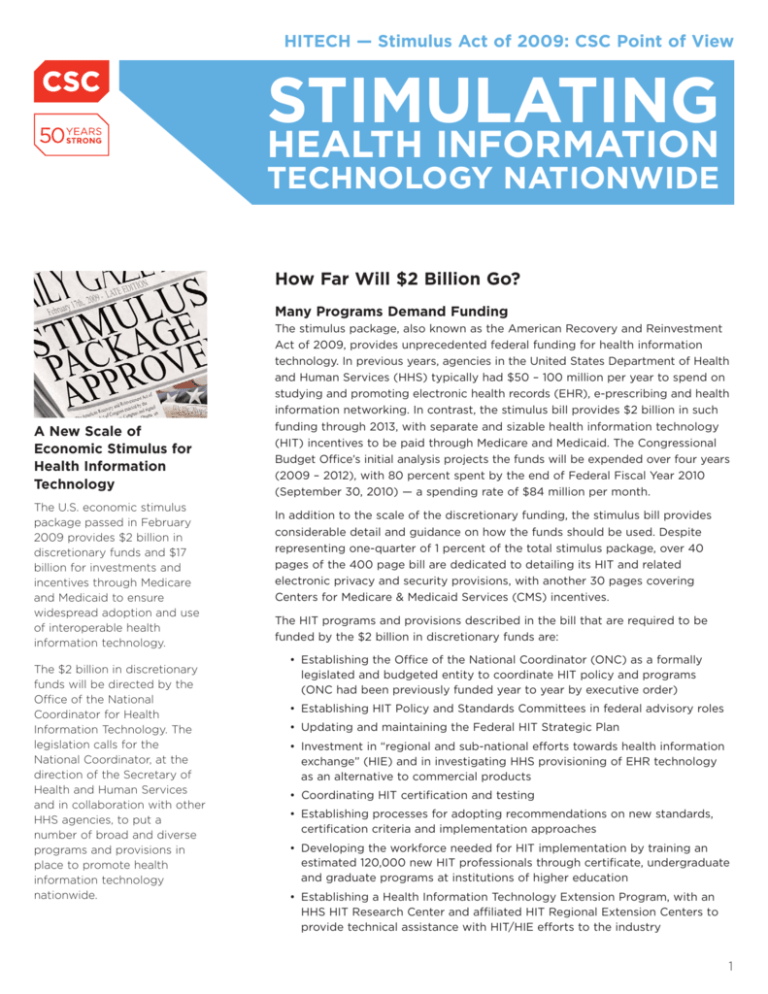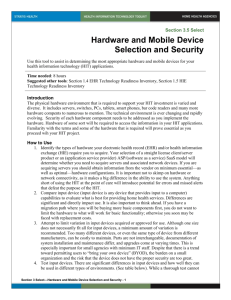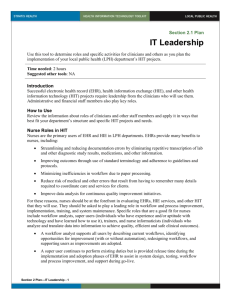
HITECH — Stimulus Act of 2009: CSC Point of View
STIMULATING
HEALTH INFORMATION
TECHNOLOGY NATIONWIDE
How Far Will $2 Billion Go?
Many Programs Demand Funding
A New Scale of
Economic Stimulus for
Health Information
Technology
The U.S. economic stimulus
package passed in February
2009 provides $2 billion in
discretionary funds and $17
billion for investments and
incentives through Medicare
and Medicaid to ensure
widespread adoption and use
of interoperable health
information technology.
The $2 billion in discretionary
funds will be directed by the
Office of the National
Coordinator for Health
Information Technology. The
legislation calls for the
National Coordinator, at the
direction of the Secretary of
Health and Human Services
and in collaboration with other
HHS agencies, to put a
number of broad and diverse
programs and provisions in
place to promote health
information technology
nationwide.
The stimulus package, also known as the American Recovery and Reinvestment
Act of 2009, provides unprecedented federal funding for health information
technology. In previous years, agencies in the United States Department of Health
and Human Services (HHS) typically had $50 – 100 million per year to spend on
studying and promoting electronic health records (EHR), e-prescribing and health
information networking. In contrast, the stimulus bill provides $2 billion in such
funding through 2013, with separate and sizable health information technology
(HIT) incentives to be paid through Medicare and Medicaid. The Congressional
Budget Office’s initial analysis projects the funds will be expended over four years
(2009 – 2012), with 80 percent spent by the end of Federal Fiscal Year 2010
(September 30, 2010) — a spending rate of $84 million per month.
In addition to the scale of the discretionary funding, the stimulus bill provides
considerable detail and guidance on how the funds should be used. Despite
representing one-quarter of 1 percent of the total stimulus package, over 40
pages of the 400 page bill are dedicated to detailing its HIT and related
electronic privacy and security provisions, with another 30 pages covering
Centers for Medicare & Medicaid Services (CMS) incentives.
The HIT programs and provisions described in the bill that are required to be
funded by the $2 billion in discretionary funds are:
• Establishing the Office of the National Coordinator (ONC) as a formally
legislated and budgeted entity to coordinate HIT policy and programs
(ONC had been previously funded year to year by executive order)
• Establishing HIT Policy and Standards Committees in federal advisory roles
• Updating and maintaining the Federal HIT Strategic Plan
• Investment in “regional and sub-national efforts towards health information
exchange” (HIE) and in investigating HHS provisioning of EHR technology
as an alternative to commercial products
• Coordinating HIT certification and testing
• Establishing processes for adopting recommendations on new standards,
certification criteria and implementation approaches
• Developing the workforce needed for HIT implementation by training an
estimated 120,000 new HIT professionals through certificate, undergraduate
and graduate programs at institutions of higher education
• Establishing a Health Information Technology Extension Program, with an
HHS HIT Research Center and affiliated HIT Regional Extension Centers to
provide technical assistance with HIT/HIE efforts to the industry
1
Important Details,
Limitations and
Matching Requirements
• Providing grants to States and State-designated not-for-profit entities
for planning and implementing programs to promote HIT adoption at the
State level
Office of the National
Coordinator
• Establishing multidisciplinary Centers for Health Care Information Enterprise
Integration at institutions of higher education for research and development
related to HIT/HIE
• Currently funded at $61
million, with ~25 FTEs
• Operating plan due May
2009
HIT Policy and Standards
Committees
• Designated as Federal
Advisory Committees
(FACAs) in the legislation
• May replace the roles of the
existing National eHealth
Collaborative (NeHC), HITSP
and CCHIT or may contract
with them
• NeHC, HITSP and CCHIT can
only assume the role(s) by
converting to FACAs
• Initial Standards Committee
policy recommendations
due May 2009
Health Information Exchange
and Federal EHR Development
• Qualify for immediate funding
• $300 million appropriated
for HIE
HIT Workforce Development
• Priority given to existing
programs and six month
curricula
• No matching requirements
HIT Regional Extension Centers
• Affiliated with non-profit
• 50 percent matching
requirement
• Four-year funding limit
• Details due by May 2009
(including available funding
and application process)
• Creating the position of Chief Privacy Officer for electronic health information
and advising on new privacy and security provisions in the bill designed to
strengthen similar provisions in HIPAA
• Developing and maintaining a website and a number of prescribed reports
on HIT, including reports on requirements for additional HIT resources and
funding
In addition, the bill introduces a number of optional programs for which portions
of the discretionary funds may be used:
• Providing grants competitively to States and Indian tribes to provide loans
and loan guarantees for providers to acquire EHR systems, upgrade systems,
train personnel or participate in HIE efforts
• Providing grants competitively to medical schools and related institutions to
create Demonstration Programs for Integrating Information Technology into
Clinical Education to better train students in the medical professions on the
use of HIT
The new Secretary and the National Coordinator have their work cut out for
them in accelerating existing efforts and getting new initiatives off the ground
quickly to achieve the desired stimulative effects of the legislation. The balance
of this white paper explores the ins and outs of making this happen, explains our
point of view on how HHS can best use their discretionary funds and provides
some ideas on how we can assist Federal, State and private sector clients in
accelerating the adoption of interoperable electronic health records to improve
health care quality nationwide.
Where Should HHS and ONC Start?
ONC is required to provide an operating plan by mid-May 2009, within 90 days
of the stimulus bill’s enactment. The obvious place to start implementing so many
ambitious programs is with what’s been started already. This includes continuing
to support regional HIE activities, building on four-plus years of prior work on
what ONC has called the Nationwide Health Information Network (NHIN). It also
includes working on the transition of predecessor public-private policy, standards
and certification committees (namely the National eHealth Collaborative, the
Health Information Technology and Standards Panel (HITSP) and the Certification
Commission for Healthcare Information Technology (CCHIT) to the new HIT Policy
and Standards Committees: the two Federal Advisory Committees specified in
the legislation.
The bill only contains two specific appropriations of the $2 billion in discretionary
HIT funding — $20 million for The National Institute of Standards and Technology
(NIST) activities and $300 million (15%) for continuing to support regional health
information exchange. In addition, the only other reference to health information
exchange activities is under the immediate funding section. This strongly suggests
that considerable funding will take place in this area in the short term, which seems
sensible since the industry is already engaged in these activities and many regional
efforts are presently under-funded. Federal investment here is likely to continue
as it has in the past, with multiple awards coordinated by ONC across many
projects and geographies, but at a much larger scale.
2
Important Details,
Limitations and
Matching Requirements
(Continued)
State Grants to Promote HIT
• State-designated entities
must be not-for-profit with
broad stakeholder
representation
• State matching
requirements by Federal
Fiscal Year (FFY)
– 2009 – 10 — HHS can
impose matching
requirements
In establishing the two new committees, ONC could easily contract with the
existing predecessors in the short-term and with additional contractors to assist
in the transition. It is likely that ONC will attempt to undertake most other
provisions of the stimulus as well, immediately and in parallel, if only to assess
how they should be funded operationally and to enlist the support of other
agencies and private interests in carrying them out.
HIT workforce development is also critically important early on, both to stimulate
new job growth and to provide the workforce for accelerated EHR and HIE
implementations. ONC can contract for academic expertise in structuring the
program required by the stimulus bill and to begin quickly making sizable awards
to colleges and universities nationwide to establish educational programs for
training new healthcare IT professionals.
Given the stimulative objectives and expectations of the legislation, and the
timing requirements and restrictions in the bill, ONC and other federal HHS
agencies can be making significant grant and contract awards in several areas
by September 30 (the end of FFY2009), including:
– 2011 — 9 percent (1:10 —
state to Federal)
• Regional and sub-national HIE efforts
– 2012 — 12.5 percent (1:7)
• HIT Regional Extension Centers
– 2013 — 25 percent (1:3)
• Academic institutions for HIT workforce development
Centers for Health Care
Information Enterprise
Integration
• Established through NIST
Grants to States and Indian
Tribes to Develop EHR Loan
Programs
• Require strategic plans for
use of funds
• 16.67 percent minimum
matching requirement (1:5),
with preference given to
higher state matching
• No awards before January 1,
2010
Demonstration Programs to
Integrate IT into Clinical
Education
• 50 percent matching
requirement
• Cannot be used to purchase
hardware, software or
services
• HIT Research Center
• State grants to promote HIT
The Congressional Budget Office (CBO) estimates that ONC outlays will increase
from current funding levels of approximately $66 million to $300 million by the
end of FFY2009. Considering how small ONC’s current staff and program scope
is today, it is almost inconceivable that the Office could reach such levels without
making programmatic spends upwards of $175 million in the above-named programs.
Doing so will also have the benefit of spreading the bureaucratic and oversight
load to regional, state and local entities, accelerating the funding’s stimulative
effect and building stakeholder support for the effort.
Is the Funding Adequate?
It should be recognized, as in the case of the AHRQ National Resource Center for
Health IT, that the $2 billion stimulus funding does not represent the sum total of
what HHS has at its disposal to promote accelerated use of interoperable electronic
health records. Nor does all the spending of the discretionary funds need to flow
through ONC. The stimulus bill, in fact, specifically references that the Secretary
of HHS “shall invest funds through … different agencies … such as” ONC, AHRQ,
the Health Resources and Services Administration (HRSA), the Centers for Medicare &
Medicaid Services (CMS), the Centers for Disease Control and Prevention (CDC)
and the Indian Health Service (IHS). All the same, considering only the $2 billion
appropriated in the stimulus package, and only the programs and provisions
identified in it, the funding seems adequate in some areas, but clearly inadequate
in others.
As a way of visualization, the following is an exercise in imagining how the $2
billion in discretionary funds might be allocated over the four years and at the
Federal Fiscal Year (FFY) levels estimated by the CBO. To be clear, the CBO
estimate of the bill’s costs is only at the top-line FFY level, not at the level of
expense categories or individual programs, and the allocations in the example do
not represent earmarks in the bill, The following exercise is merely an attempt at
reflecting the bill’s program limitations as to implementation timetables and
matching requirements tied to the CBO estimated funding level and four year
spread. The projection reflects what we perceive to be the overall HIT initiative’s
3
priorities (continuing existing activities, spending early on workforce development,
and enlisting states and regional entities in spreading the stimulus) using the
context of the CBO outlay estimate and timeframe (ignoring that the legislation
allows the funding to be spent over an additional year, through 2013). One other
note: as in the CBO estimate, the following estimate does not include the $20
million appropriation to NIST from the $2 billion, and it assumes that the Enterprise
Integration Research Centers that the bill requires to be established by NIST will
be funded from that appropriation or from other NIST funding sources.
At $300 million over an anticipated three years, funding for regional and sub-national
HIE represents a fourfold increase over the approximately $70 million ONC and
CMS have released for NHIN projects over the last three years. Augmented by
funding for HIT Regional Extension Centers and state grants to promote HIT, each
state could receive $10 – 20 million for health information exchange and EHR
adoption over the next 18 – 24 months, independent of funds for training and
workforce development. In those areas, funding seems adequate to seed sizable
academic programs at 40 – 50 institutions of higher learning aimed at medical
professionals and at developing a new HIT workforce.
States, educational institutions and groups wishing to serve as Regional Extension
Centers will need to secure matching funds to win stimulus funding. This may
prove challenging in today’s tough revenue and credit markets, so it is difficult
to imagine that the authorities, institutions and entities involved could absorb
and put to use more federal funds even if they were made available.
FFY2009
($300)
FFY2010
($1,280)
FFY2011
($360)
Staff and Administrative Expenses
$27.5
$35
$31
$30
$125.5
Policy Coordination — Contract Services
$51.5
$58.5
$33.5
$5
$148.5
$46
$56.5
$28.5
$5
$133
$175
$1,130
$270
—
$1,575
• Regional and Sub-National HIE
$20
$230
$50
—
$300
• HIT Regional Extension Centers
$35
$190
—
$260
—
—
—
—
$20
$20
$20
—
$60
CBO Funding Estimate by Year
(in millions)
FFY2012 Total Outlay
($40)
($1,980)
• HIT Policy Committee
• HIT Standard Committee
• Standards and certification adoption/promotion
• Quality measurement adoption/promotion
Program Management — Contract Services
• Regional and Sub-National HIE
• HIT Research Center
• HIT Regional Extension Centers
• Enterprise Integration Research Centers
• Federal HIT Development
• Demonstration Program — HIT in Clinical
Education
• HIT Professional Workforce Development
• State Grants to Promote HIT
• State and Indian Grants — EHR Loan Funds
Grant Contracts and Awards — Direct Funding
• Enterprise Integration Research Centers
• Demonstration Program — HIT in Clinical
Education
• HIT Professional Workforce Development
$60
$150
$35
—
$245
• State Grants to Promote HIT
$40
$265
$30
—
$335
—
$275
$100
—
$375
• State and Indian Grants — EHR Loan Funds
4
At the same time, it is difficult to believe that federal agencies, including ONC, can
scale up quickly enough to administer the funds available in the stimulus, much
less additional funds. Nor would such a rapid growth in the federal bureaucracy
necessarily be desirable, since the point of the stimulus is primarily to promote
economic and job growth in the private sector.
Where the funding seems inadequate is in two areas. First, grants to establish
EHR Loan Funds through the States and Indian tribes cannot begin to provide
enough capital for the required investment in interoperable EHRs. Studies have
estimated that $100 – 160 billion in initial capital is required to implement EHRs
nationwide, not including operating costs.
The second area where funding may be inadequate is in sustaining EHR operations
and HIE. A massive federal investment over then next three to five years will create
not only an administrative bureaucracy, but also ongoing operational costs for
many of the entities and programs providing support. Cost savings from interoperable
EHR are not expected to fully recover capital and operating costs over the same
period, and adoption incentives from CMS and private payers will only partly
help finance the investment over a longer period.
About CSC
The mission of CSC is to be
a global leader in providing
technology enabled business
solutions and services.
With the broadest range of
capabilities, CSC offers clients
the solutions they need to
manage complexity, focus
on core businesses, collaborate
with partners and clients, and
improve operations.
CSC makes a special point
of understanding its clients
and provides experts with realworld experience to work with
them. CSC is vendor-independent,
delivering solutions that best meet
each client’s unique requirements.
For 50 years, clients in industries
and governments worldwide have
trusted CSC with their business
process and information systems
outsourcing, systems integration
and consulting needs.
Wisely, one of the provisions of the stimulus bill requires ONC to “estimate and
publish resources required annually to reach the goal of utilization of an electronic
health record for each person in the United States by 2014”, with the first such
report due in February 2010.
Recommendations
We recommend that every organization develop a process for tracking ONCIT
plans and funding opportunities. The next key deliverable will be the ONCIT
operating plan that is due in mid-May 2009.
Grants and loan programs for HIT will be planned and administered by the states.
By becoming involved in state level efforts, organizations can help ensure that
these monies are secured and used effectively.
Training of both IT and clinical professionals will be required to achieve the vision
of universal, effective EHR use. Experienced people will be in short supply. Some
organizations may want to partner with educational institutions to apply for
grant money to provide training programs.
About the Author
Greg DeBor is a Client Partner for CSC’s Healthcare Group. For more information
on Program Funding, please contact: gdebor@csc.com or
healthcaresector@csc.com.
Transforming Healthcare with Better Information for Better Decisions
The company trades on the New
York Stock Exchange under the
symbol “CSC.”
CSC
266 Second Avenue
Waltham, Massachusetts 02451
United States
+1.800.272.0018
www.csc.com
Copyright © 2009 Computer Sciences
Corporation. All rights reserved.
ny09_0152
March 2009
5







